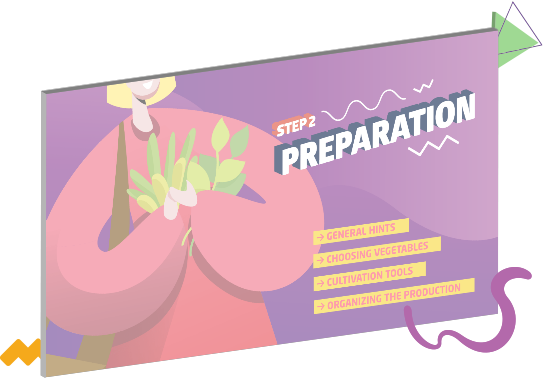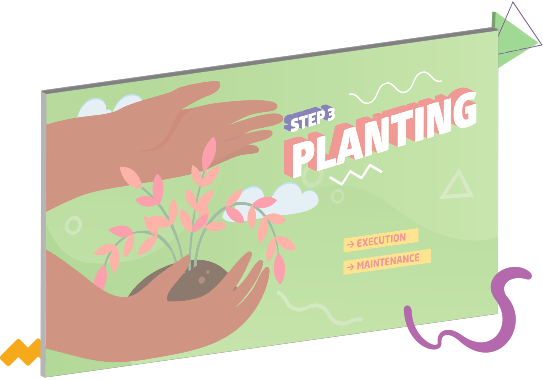☰
 Peace Builders; Green operation
Peace Builders; Green operation
About
Creating a vegetable garden from scratch goes beyond providing a source of healthy food. The experience can serve as a laboratory and stimulate collaborative work, in which responsibilities and results are shared between the students and the community! So what about creating a green space at your school or surrounding areas? There are several possibilities! Let’s get started!

Learning
path
1 path
The ideal place
The ideal place
During this step, you are going to learn about different types of garden. You will also choose which one would be most appropriate for the space that is available.
Preparation
Preparation
During this step, the class will be organized in groups in order to choose the vegetables that are going to be planted and provide the necessary materials.
Planting
Planting
The time has come to put knowledge into practice! Besides creating a garden with your colleagues, you are also going to learn how to look after it.
Follow-up
Follow-up
The work goes on! During this step, you are going to follow up on the development of the garden to check if it is progressing as expected. You will also decide on the future of the crop.
STEP 1:
The ideal place
Before planting, there is a very important step involving analysis that you can't skip. For example, do you know the basic conditions to plant a garden? And in which ways a garden can be structured? It is necessary to know these answers in order to choose the most viable place for the garden. Let’s get started! Click on the infographic.
TASKS:
With your colleagues, choose a type and a place for the garden. Write down the pros and cons of each possible area in order to justify your choice.
SKILLS:
You will develop analytical thinking and teamwork skills.
!Analytical thinking is fundamental to make careful decisions. Teamwork is also a very important skill that you practice when you express your ideas respectfully and accept the ideas of others.
Glossary
- attached: acoplado/a; fixado/a; anexado/a.
- container: recipiente.
- exposure: exposição.
- flowerpot: vaso.
- from scratch: do zero.
- maintenance: manutenção.
- overcome: superado/a.
- pros and cons: prós e contras.
- rope: corda.
- sewage: esgoto.
- stairwell: escadaria.
- tied up: amarrado/a.
- viable: viável.
STEP 2:
Preparation
Test your knowledge about the
previous step to move forward.
TAKE THE QUIZ
skip test
previous step to move forward.
What is the main task during this step?
Choose the place where the garden is going to be.
What is an important characteristic of the space for the development of a garden?
Good exposure to sunlight.
In what situation are vertical gardens recommended?
When there is only a small amount of space to cultivate.
Think about the questions below, then share your experience on Students for PEACE Social Media:
- Which location did you choose to cultivate the garden? Why?
- Was it difficult to find an adequate space? Why?
- Which type of garden are you going to create? Why?
Tags: peacebuilders; garden; step1
It is time to learn how to plant! Each vegetable has its own specific qualities: the ideal time to be cultivated, the area needed for it to develop, the harvest time, among other things. During this step, you are going to do some research on vegetables to evaluate which ones best adapt to the type of garden chosen in the previous step. You will also provide the material to cultivate them. You don’t know where to begin? Click on the infographic.
TASKS:
The class will be divided into groups; each group must research into three different vegetables and choose the one that best adapts to the type of garden defined. The group must then provide the necessary materials.
SKILLS:
You will work on research, data analysis and organization skills as well as improve your knowledge about soil and planting.
!Good research from reliable sources is very important to build knowledge. Developing a sense of organization will help you save time and avoid problems when working in a team. Finally, getting to know how to use the soil collaborates with more sustainable and conscious manners.
Glossary
- depth: profundidade.
- dryness: ressecamento.
- fill in: preencher.
- harvest: colheita.
- hint: dica.
- hole: buraco.
- improve: melhorar.
- level out: nivelar.
- manners: modos.
- mild: ameno/a.
- own: próprio/a.
- press down: pressionar.
- provide: providenciar.
- reliable: confiável.
- remain (verb): permanecer.
- remains (noun): resto.
- root: raiz.
- save time: economizar tempo.
- seedling: muda.
- soil: solo.
- source: fonte.
STEP 3:
Planting
Test your knowledge about the
previous step to move forward.
TAKE THE QUIZ
skip test
previous step to move forward.
Why is it important to research before starting to cultivate?
Because plants have specific cultivation characteristics.
When is the best time to water the vegetables?
In the beginning or at the end of the day, when the soil is dry.
Click on the incorrect affirmation about the soil for planting.
A mixture to prepare the soil should contain 1/2 sand, 1/2 stones and water.
Think about the questions below, then share your experience on Students for PEACE Social Media:
- Which vegetables were chosen?
- Was it easy to choose them? Explain.
- Which task during this step most motivated you (research, data analysis, supplying the materials)? Why?
Tags: peacebuilders; garden; step2
All of the materials have been provided, so it is time to put everything that you have learned into practice. But the work won’t be finished after planting the garden. It is necessary to know how to look after it so that the garden develops well until the harvest. Click on the infographic to learn more.
TASKS:
Plant the vegetables and look after them.
SKILLS:
You will develop skills related to gardening and responsibility.
!Looking after the garden allows you to observe the transformations occurring in the soil and in nature, increasing your knowledge of the environment. And when you are responsible for something, you gain a purpose, which is very important for the development of personal and professional projects.
Glossary
- crop: colheita; cultura agrícola; safra.
- downwards: para baixo.
- drip: escorrer; pingar.
- from up above: da parte de cima.
- leafy: folhoso/a.
- look after: cuidar de.
- pest: praga.
- purpose: propósito.
- squash: esmagar.
- throw: jogar.
- weed: erva daninha.
STEP 4:
Follow-up
Test your knowledge about the
previous step to move forward.
TAKE THE QUIZ
skip test
previous step to move forward.
Click on the option that best represents the correct order.
Dig a hole, throw in the seeds, fill in the hole, irrigate.
In general, stones and weeds should be removed from the garden because...
... they suffocate the garden and interfere in the absorption of the sunlight, water and nutrients.
Why is it important to rotate the crops in the garden?
Because it helps restore the soil and avoid pests.
Think about the questions below, then share your experience on Students for PEACE Social Media:
- How was the experience of creating a garden from scratch?
- Who helped you during this step?
- What was the most challenging step for you? Why?
Tags: peacebuilders; garden; step3
This step can seem similar to the maintenance stage, but it is more related to correct any problems and improve results. You will go back to a more analytical type of work to verify if the garden is progressing as expected and to prepare long/medium-term plans. You will also think about the destination of the harvest. Click on the infographic to learn more.
TASKS:
Follow up on the development of the garden to verify if it is progressing as expected and choose the destination of the harvest.
SKILLS:
You will develop abilities related to preparing data for analysis, critical thinking and proactive problem solving.
!These skills are fundamental not only for the project and research development but also for your personal life because they favor less impulsive decisions.
Glossary
- assess: avaliar.
- favor: favorecer.
- follow up (verb): acompanhar.
- follow-up (noun): acompanhamento.
- reach a consensus: chegar a um consenso, a um acordo.
- well-lit: bem iluminado/a.
- whether: se.
Test your knowledge about
the previous step.
TAKE THE FINAL QUIZ
skip test
the previous step.
Which alternative below is not a good option for the destination of the crops?
Let them planted for decorative purposes.
What is the major advantage of photographing or filming the development of the vegetables?
Observe the different stages of growth in a clearer way and compare them.
If there is a garden that hasn’t grown as expected, what do you need to do?
Formulate a hypothesis, investigate and test alternatives.
Congratulations!
You created a garden.
Think about the questions below, then share your experience on Students for PEACE Social Media:
- What are you going to do with the vegetables after the harvest?
- Were there any vegetables that presented problems during their development? If so, what did you do to solve them?
- Which step did you like the most and which step did you like the least? Why?
Tags: peacebuilders; garden; step4
Peace Builders
credits
- Publishing Director: Sandra Possas
- Multiplatform Editorial Manager: Adriana Pedro de Almeida
- Multiplatform Design and Production Coordinator: Raquel Buim
- Content: Patrícia Pinheiro de Sant'Ana
- Translation: Rodney Daniel Cameron
- Multiplatform Content Editor: Ana Paula Campos, Gabrielle Navarro (Teacher’s Guide)
- Proofreading Coordinator: Gislaine Caprioli
- Proofreaders: Letícia Della Giacoma de França, Thais Giammarco
- Multiplatform Designers: Daniela Carrete, Frodo Almeida, Karina Vizeu Winkaler, Mateus Banti
- Multiplatform Photo Researcher: Sara Alencar
- Photos: Layout: invincible_bulldog/iStockphoto; Ponomariova_Maria/iStockphoto; TopVectors/iStockphoto; lankogal/iStockphoto. Step 1: youngvet/iStockphoto; yoh4nn/iStockphoto; Wildroze/iStockphoto; rubiophoto/iStockphoto; Westbury/iStockphoto; PamelaJoeMcFarlane/iStockphoto; Geo-grafika/iStockphoto; simonidadjordjevic/iStockphoto; ThitareeSarmkasat/iStockphoto; Naphat_Jorjee/iStockphoto; Piyachok/iStockphoto; Karinprijs/iStockphoto; boonsom/iStockphoto; CreativeNature_nl/iStockphoto. Step 2: HelgaMariah/iStockphoto; ozenli/iStockphoto; Viorika/iStockphoto; talipcubukcu/iStockphoto; Laborer/iStockphoto; Pawel_B/iStockphoto; Qvasimodo/iStockphoto. Step 3: Pongasn68/iStockphoto; Avalon_Studio/iStockphoto; Volosina/iStockphoto; Vitalina/iStockphoto. Step 4: firina/iStockphoto; redhumv/iStockphoto; Westbury/iStockphoto
- Videos: Step 3: Excerpts from 16 BEAUTIFUL DIY IDEAS FOR YOUR GARDEN. Published by 5-Minute Crafts; 23 GENIUS IDEAS FOR YOUR GARDEN. Published by 5-Minute Crafts
- Programming: CPCi Produtora Digital, Daniela Carrete
- Accessibility
- Closed Caption: Ana Paula Campos
- Images Description: Ana Paula Campos
- Every effort has been made to trace the holders of copyright, but if any omissions
can be rectified, the publishers will be pleased to make the necessary arrangements.
- All rights reserved.
- © Editora Moderna
- Richmond
- Editora Moderna Ltda.
- Rua Padre Adelino, 758 — Belenzinho
- São Paulo — SP — Brasil — CEP 03303-904
- Central de atendimento ao usuário: 0800 771 8181




